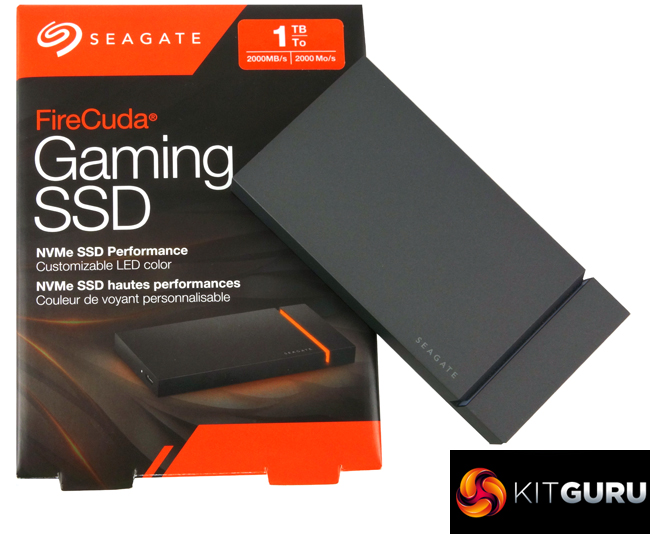The latest addition to Seagate's FireCuda Gaming product line is the FireCuda Gaming SSD external drive which sports along with an NVMe SSD, a USB 3.2 Gen2 x2 interface, the first external drive we've seen using (at the time of writing) the fastest USB connection available.

The FireCuda Gaming SSD is available in three capacities; 500GB, 1TB (our review sample) and a 2TB flagship model. Internally the drive uses one of Seagate's own FireCuda 510 NVMe SSD's which uses a combination of a rebranded Phison PS5012 8-channel controller and Toshiba BiCS3 64-layer 3D TLC NAND together with an ASMedia bridging IC. All three drives have the same up to 2,000MB/s read/write performance rating.
When tested with the ATTO benchmark we could confirm that 2,000MB/s maximum read figure with a test result of 2,059MB/s. Writes didn't quite get to the maximum, topping out at 1,988MB/s. However, using CrystalDiskMark 7 we saw Sequential figures that bettered the official maximums. The default test saw reads of 2,076MB/s with writes at 2,104MB/s while the Peak Performance profile default gave 2,080MB/s and 2,105MB/s for read and writes respectively. Using the default Real World profile we got 1,542MB/s for reads and 1,845MB/s for writes.
Scrolling through the manual for the FireCuda Gaming SSD we came across this interesting segment. “There may be instances when the drive experiences an involuntary disconnect or error while writing or reading files when connected to a USB 3.2 Gen 2×2 port. If you encounter this issue, you can reduce the chances of recurring problems by disabling full performance for FireCuda Gaming SSD”. We didn't come across any problems with the drive until we started the real-life file testing and indeed there were disconnect errors when attempting to transfer data from the 60GB Steam, 50GB file, 12GB movie folders and the DVD transfer. For all the other real-life file tests, the drive worked without any problems as well as working perfectly when using a USB 3.2 Gen 2 or Gen 1 connection.
Seagate's Toolkit utility is a useful utility for looking after the drive and the data on it. It provides tools backing up and syncing your files and support for the FireCuda Gaming's RGB LED lighting.
The lighting options would be pretty impressive for an internal disk never mind an external one. There are three single colour default options; Solid (displays single colour), Blink (single colour, 6 sec animation time 50% on,50% off) and Breathe (custom animation time, single colour fade) and a single multicolour option, Spectrum (transitions between 6 colours with custom animation time). If none of these floats your boat then there are three Custom patterns with choices of transition and hold times and multiple colour choices. There's a preview window where you can the choices you've made in action before you select them.
Seagate may be a little “caught between a rock and a hard place” with the FireCuda Gaming SSD as USB 3.2 Gen 2 x2 supporting systems are very thin on the ground at the time of writing this review at least, and then there is the looming shadow of USB4.
We found the 1TB version of the Seagate FireCuda Gaming SSD on Overclockers UK for £259.99 (inc VAT) HERE.
Discuss on our Facebook page HERE.
Pros
- Overall performance.
- RGB lighting.
- 5-year warranty.
Cons
- Needs a USB 3.2 Gen 2 x2 interface to get the best out of it.
- Odd disconnect problems in some of our real-life tests.
- Pricey.
KitGuru says: Seagate's FireCuda Gaming SSD is a fast performing external drive but at the time of writing finding a system with a USB 3.2 Gen 2 x2 port is rather like looking for a needle in a haystack.
 KitGuru KitGuru.net – Tech News | Hardware News | Hardware Reviews | IOS | Mobile | Gaming | Graphics Cards
KitGuru KitGuru.net – Tech News | Hardware News | Hardware Reviews | IOS | Mobile | Gaming | Graphics Cards




